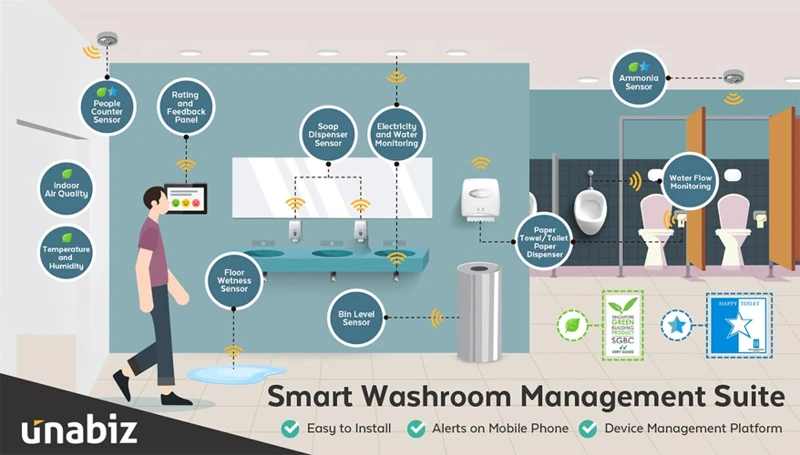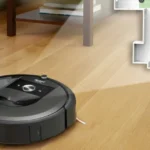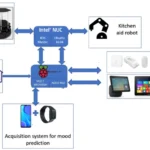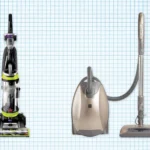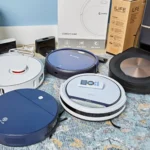Picture this: you come back home after a long day at work, and the last thing you want to do is spend hours cleaning your house. But what if you didn’t have to? What if your vacuum cleaner could do all the work for you with increased efficiency, reduced energy consumption, minimal human intervention, and improved cleaning performance? Sounds too good to be true? Well, with the help of smart sensors, it is not only possible but has become a reality. Smart sensors are revolutionizing the way we clean our homes, making it quicker, easier, and more effective than ever before. In this comprehensive guide, we will look at how smart sensors improve cleaning efficiency, the types of sensors used in smart vacuum cleaners, their benefits, how they work, and factors to consider when buying a smart vacuum cleaner. So, buckle up, and let’s drive into the world of smart sensors in vacuum cleaners!
How Do Smart Sensors Enhance Cleaning Efficiency?
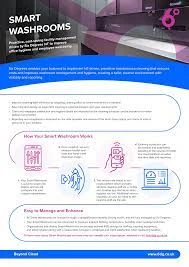
Smart sensors are an innovative solution for improving cleaning efficiency in smart vacuum cleaners. These sensors are integrated into the device to enhance their cleaning performance automatically. They utilize various technologies to make a vacuum cleaner more efficient and autonomous.
Understanding Smart Sensors
Smart sensors refer to devices that are designed to detect, measure, and respond to physical inputs from the environment. In the context of a smart vacuum cleaner, these sensors perceive the surrounding environment and collect data on it to optimize the device’s cleaning efficiency. Such sensors can detect obstacles, changes in surface types, as well as the presence of pet hair.
Benefits of Smart Sensors
There are numerous benefits to incorporating smart sensors into a smart vacuum cleaner. Firstly, sensors provide a means for minimizing human intervention in the cleaning process. This system is ideal for busy people who don’t have time to clean their homes regularly.
Another benefit is that smart sensors improve navigation and mapping in smart vacuum cleaners. Sensors help the device to determine its precise location and avoid obstacles while cleaning. This is particularly important for large spaces where there is a lot of furniture or objects around.
Types of Smart Sensors for Vacuum Cleaners
There are several types of smart sensors available for smart vacuum cleaners. They include:
- Optical Sensors: These sensors use light to detect the dirt, dust, and debris present in the cleaning path. They are precise and allow the vacuum cleaner to detect the location and size of the dirt particles.
- Infrared Sensors: These sensors are equipped to detect the presence of obstacles, including furniture, walls, and other barriers. They can detect the height, width, and distance between objects and thus aid in their avoidance.
- Ultrasonic Sensors: Ultrasonic sensors use sound waves to detect obstacles and other objects in the cleaning path. They are efficient and can even detect the presence of glass or transparent objects in the path.
- Tactile Sensors: These sensors use touch to determine the surface type and detect the presence of obstacles in the cleaning path. They are ideal for hard floors, carpets, and other surfaces.
- Acoustic Sensors: These sensors detect noise levels in the environment and reduce vacuum cleaner noise accordingly. This technology ensures that your vacuum cleaner doesn’t make a lot of noise while cleaning, thereby making it more suitable for use in an office, library, or home when someone is sleeping.
Working of Smart Sensors in Smart Vacuum Cleaners
Smart sensors work by passing electrical signals to a microcontroller, which interprets the data and performs the necessary actions. They use a variety of technologies such as infrared, ultrasonic, and optical sensing to detect obstacles and other objects, as well as to optimize cleaning efficiency overall. By using sophisticated algorithms, smart sensors in a vacuum cleaner can detect variations in surface types, user preferences, and even detect the presence of pets in the area.
Smart sensors are an integral component of smart vacuum cleaners that enhance their cleaning efficiency. They help detect different types of obstacles, perform better navigation and mapping, and detect surface types to adjust to their cleaning methods accordingly. If you want to learn more about the different types of smart sensors used in smart vacuum cleaners, consider visiting the Types of Sensors Used in Smart Vacuum Cleaners section.
1.1 Understanding Smart Sensors
Smart sensors have revolutionized the way cleaning has traditionally been done. They have greatly improved cleaning efficiency by making the cleaning process smarter, more accurate, and more reliable. Understanding what smart sensors are and how they work is crucial to understanding the benefits they bring to your cleaning routine. Smart sensors refer to advanced technology that uses various sensing mechanisms to detect specific environmental changes, adjust to them, and provide a suitable response. These sensors come in different types and are designed to serve specific purposes in vacuum cleaners, from obstacle detection to indoor mapping, carpet cleaning, noise reduction, and more. In the following sections, we will delve deeper into the types of smart sensors available and how they work.
1.2 Benefits of Smart Sensors
Smart sensors are equipped with advanced technologies that enhance and upgrade the performance of various devices. Similarly, in the case of vacuum cleaners, smart sensors play an essential role in revolutionizing the cleaning experience. Let’s explore the benefits of smart sensors in detail:
| Benefits | |
|---|---|
| Noise Reduction | The smart sensors in smart vacuum cleaners come with the technology that accurately detects noise and adjusts the suction power to prevent loud noise during cleaning. Hence, these machines are less noisy than traditional vacuum cleaners. |
| Efficiency | The efficient performance of smart sensors ensures that no debris or dust is left behind during the cleaning process, significantly improving cleaning efficiency. Their ability to map the surroundings and detect obstacles assists in devising an appropriate cleaning plan, making the process more efficient. |
| Indoor Mapping | The indoor mapping technology in smart vacuum cleaners allows them to map the indoor space with precision that results in effective cleaning. With this technology, they can recognize objects, walls, and furniture and avoid bumping into them. |
| Carpet Cleaning | The smart sensors in vacuum cleaners can detect the type of surface they are cleaning, adjusting the suction power accordingly. For example, when cleaning carpets, they increase the suction power to collect small dust particles and debris. Therefore, carpet cleaning is made easier and more efficient. |
| Obstacle Detection | Smart sensors in vacuum cleaners can detect and maneuver around obstacles such as furniture, walls, and other objects found on the floor, preventing any potential damage. This feature reduces the risk of accidents, making the cleaning process safer. Learn more about smart sensors obstacle detection. |
The benefits of smart sensors in vacuum cleaners cannot be overemphasized. From reduced noise to efficient cleaning and obstacle detection, smart sensors have revolutionized the way we clean our indoor spaces. With technological advancements continuously improving, we can only imagine the new benefits smart sensors would bring to vacuum cleaners in the future.
1.3 Types of Smart Sensors for Vacuum Cleaners
When it comes to smart vacuum cleaners, there are several types of smart sensors that have been developed to help improve their efficiency in cleaning spaces. Let’s take a closer look at some of the most common types of smart sensors for vacuum cleaners.
1. Optical sensors: These sensors use light to detect various surfaces and obstacles in their path. Optical sensors are especially useful for detecting shiny or reflective surfaces that might be missed by other types of sensors.
2. Infrared sensors: Infrared sensors use infrared light to detect obstacles and surfaces. They are commonly used in smart vacuum cleaners for detecting furniture and other objects in their path.
3. Ultrasonic sensors: Ultrasonic sensors use soundwaves to detect objects and surfaces. They emit a high-pitched frequency that is unable to be heard by humans, and then measure how long it takes for the soundwaves to bounce back to the sensor. These types of sensors are very useful in detecting small objects and can be used to map out rooms more accurately.
4. Tactile sensors: Tactile sensors are designed to detect physical contact with objects. They are often found on the sides of smart vacuum cleaners and can detect if the vacuum cleaner has come into contact with a wall, piece of furniture, or other object.
5. Acoustic sensors: Acoustic sensors are similar to ultrasonic sensors in that they use soundwaves to detect objects and surfaces. However, they emit a lower frequency sound than ultrasonic sensors, and are useful for detecting larger objects and for creating noise maps of a room.
By utilizing one or more of these smart sensors, a vacuum cleaner can map out a room, detect obstacles and surfaces, and create an efficient cleaning path. This can lead to a more thorough cleaning, ultimately saving time and energy for the user.
1.4 Working of Smart Sensors in Smart Vacuum Cleaners
Smart sensors play a crucial role in enhancing the cleaning efficiency of a smart vacuum cleaner. It essentially allows the machine to function in an autonomous manner, detecting obstacles and adjusting suction power according to the surface type. Let’s take a closer look at how smart sensors actually work in smart vacuum cleaners.
The working of smart sensors in smart vacuum cleaners can be broadly categorized into the following steps:
- Detection: Smart sensors detect any obstacles or potential dangers in the cleaning area. These can be anything from furniture to stairs, and even pets.
- Analysis: The data collected by the sensors is analyzed by the vacuum cleaner’s software to determine the best course of action. For example, if the machine detects an obstacle, it will try to maneuver around it or adjust its suction power to avoid a collision.
- Action: Based on the analysis, the smart vacuum cleaner decides on the appropriate action to take. It may alter its path, adjust suction power, or turn on/off certain features like edge cleaning or pet hair detection to better clean the area.
- Feedback: Once the action is taken, the smart sensors provide feedback to the software to ensure that the machine is performing optimally. For example, if the machine detects that it missed a spot, it will go back and clean it again.
The working of smart sensors in smart vacuum cleaners can be broken down into detection, analysis, action, and feedback. This allows the machine to operate in a more autonomous and efficient manner, ultimately leading to better cleaning results.
Types of Smart Sensors Used in Smart Vacuum Cleaners
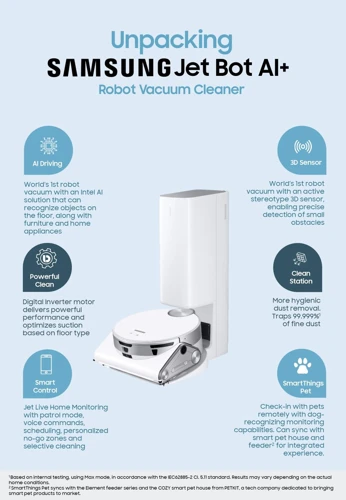
Smart vacuum cleaners are designed to provide an effortless cleaning experience by using advanced technologies like smart sensors. These sensors are able to detect obstacles, map out the cleaning area, and adjust the suction power accordingly. They are also essential in identifying different surface types and ensuring that the vacuum cleaner provides optimal cleaning. In this section, we will be discussing the different types of smart sensors used in smart vacuum cleaners.
1. Optical Sensors: Optical sensors are one of the most popular types of sensors used in smart vacuum cleaners. They work by detecting changes in light and can detect the edges of carpets and other obstacles. They are also useful in detecting dust and dirt on the floor.
2. Infrared Sensors: Infrared sensors are another popular type of sensor used in smart vacuum cleaners. They are able to detect the presence of objects and can be used to avoid obstacles like furniture and walls. They can also help the vacuum cleaner to navigate uneven surfaces like stairs.
3. Ultrasonic Sensors: Ultrasonic sensors use sound waves to detect objects and obstacles. They are designed to detect the distance between the vacuum cleaner and an object and can be used to adjust the suction power accordingly. They are particularly useful in detecting smaller obstacles like toys or cables.
4. Tactile Sensors: Tactile sensors are designed to detect the physical contact that the vacuum cleaner makes with objects. They are useful in identifying obstacles like furniture or walls and can help the vacuum cleaner to navigate around them.
5. Acoustic Sensors: Acoustic sensors work by detecting sounds and vibrations. They can identify changes in sound patterns like the sound of dirt being sucked up by the vacuum cleaner. This enables the vacuum cleaner to provide better cleaning performance by adjusting the suction power accordingly.
Smart sensors are an integral part of smart vacuum cleaners. They enable the vacuum cleaner to navigate around obstacles, detect different surface types, and adjust suction power accordingly. By using different types of sensors together, smart vacuum cleaners can provide a more efficient and comprehensive cleaning experience. It is important to consider the type of sensors used in a smart vacuum cleaner when making a purchase, as they can greatly affect the cleaning performance.
2.1 Optical Sensors
When it comes to smart vacuum cleaners and their sensors, optical sensors are a popular choice among manufacturers. These sensors use light waves to detect obstacles and other objects in the vacuum’s path, allowing for efficient navigation and cleaning. But what sets optical sensors apart from other types of sensors? And how exactly do they work? Let’s dive into the details of optical sensors and their role in improving cleaning efficiency.
2.2 Infrared Sensors
Infrared sensors are another type of smart sensor used in smart vacuum cleaners to enhance cleaning efficiency. These sensors work by emitting infrared rays and using the reflection of those rays to detect obstacles and map the cleaning area. Some of the key features of infrared sensors in smart vacuum cleaners include:
- Obstacle detection: Infrared sensors can detect objects like furniture and walls and signal the vacuum cleaner to change its direction or avoid the objects altogether.
- Mapping: The reflection of infrared rays can be used to create a map of the cleaning area, which can be beneficial for navigation and determining the most efficient cleaning path. This mapping feature also helps the vacuum cleaner to remain on course and not repeat sections.
- Precision: Infrared sensors offer a high degree of precision in obstacle detection and mapping, making them an attractive option for smart vacuum cleaners.
- Energy Efficiency: Infrared sensors require minimal power to operate, which makes them energy-efficient and reduces the overall power consumption of the vacuum cleaner.
Infrared sensors are an essential component of smart vacuum cleaners, as they offer superior obstacle detection and mapping capabilities. These sensors enable the vacuum cleaner to be more efficient, precise, and energy-efficient, enhancing the overall cleaning experience.
2.3 Ultrasonic Sensors
Ultrasonic sensors are another commonly used type of smart sensor found in smart vacuum cleaners. These sensors utilize high frequency sound waves to detect any obstacles in the vicinity of the vacuum cleaner. This is done by emitting a sound wave and then measuring the time taken to receive its echo after it has reflected off an object in the path of the vacuum cleaner.
Some distinct advantages of ultrasonic sensors are:
- Highly accurate detection of objects in front of the vacuum cleaner
- Ability to detect objects at a greater distance than other types of sensors
- Works effectively in low light environments
- Can detect objects of different shapes and sizes
Ultrasonic sensors are particularly useful in detecting obstacles that are not within the line of sight of other sensors. For example, tall objects such as furniture legs or plant stands can be detected by ultrasonic sensors even if they are not visible to the vacuum cleaner’s camera or lidar sensors.
However, it’s important to note some limitations of ultrasonic sensors:
- Not as effective in detecting thin or flat objects such as rugs or mats, as the sound waves may pass through them without reflecting back
- May not work well in environments with high levels of ambient noise or echoes
- May have difficulty distinguishing between objects that are close together
Ultrasonic sensors add an important layer of detection and obstacle avoidance to a smart vacuum cleaner’s sensor suite. In combination with other sensors such as cameras and lidar, ultrasonic sensors help to ensure that the vacuum cleaner can navigate smoothly and efficiently around a room, avoiding any obstacles in its path.
2.4 Tactile Sensors
Tactile sensors, as the name suggests, rely on the sense of touch to collect data. These sensors are placed on the underside of the vacuum cleaner and make contact with the surface being cleaned. When the sensor comes in contact with an obstacle or surface transition, it sends a signal to the vacuum cleaner’s control unit, which then adjusts the vacuum cleaner’s path to avoid the obstacle or adjust the suction power to clean the different surface.
Table: Types of Tactile Sensors
| Type of Tactile Sensor | Functionality |
|---|---|
| Switch Sensor | Registers yes/no input (i.e., contact or no contact with an obstacle) |
| Strain Gauge Sensor | Measures the amount of force or pressure applied to the sensor |
| Capacitive Touch Sensor | Registers when a surface is touched or in close proximity to the sensor |
| Force-Sensitive Resistor Sensor | Measures the amount of force applied to the sensor |
The information collected from tactile sensors not only ensures that the vacuum cleaner navigates safely and accurately around furniture and room transitions, but it also helps the vacuum cleaner adjust its cleaning performance according to the surface it is cleaning. For instance, if tactile sensors detect that the vacuum cleaner is cleaning a carpet, it will increase suction power to ensure a thorough cleaning.
The use of tactile sensors helps deliver more efficient and automated cleaning by ensuring that the vacuum cleaner can operate effectively and navigate safely.
2.5 Acoustic Sensors
Acoustic sensors are used in some smart vacuum cleaners as an alternative to the more commonly utilized optical and infrared sensors. These sensors are capable of detecting sound waves and processing them to help the vacuum cleaner distinguish between different objects and surfaces in the room.
Here are some key features of Acoustic Sensors:
- The main advantage of acoustic sensors is their ability to provide a more precise understanding of the environment a vacuum cleaner is operating in, as they can capture micro movements and sound waves that are outside the range of other sensors.
- Acoustic sensors are particularly useful for detecting and navigating objects that are not easily visible, such as furniture that is partially obstructed by other objects in the room.
- These sensors can also help a vacuum cleaner to distinguish between different types of surfaces, such as carpet, hardwood, or tile floors, based on the sound waves that are reflected off of each surface.
- Acoustic sensors work by emitting sound waves and measuring how long it takes for those sound waves to bounce back after they hit an object or surface. In this way, they can create a kind of map of the room that they are operating in.
- The data captured by acoustic sensors is processed by the vacuum cleaner’s onboard computer, which uses complex algorithms to decide how to navigate around the room and what level of suction power to apply on each surface.
- Some smart vacuum cleaners employ acoustic sensors in combination with other types of sensors, such as optical or infrared sensors, to achieve a more accurate and detailed understanding of the cleaning environment.
- The use of acoustic sensors in smart vacuum cleaners is gaining popularity, as they offer a high degree of precision and efficiency in the detection of obstacles and surfaces, allowing the vacuum cleaner to move around the room smoothly and avoid getting stuck or colliding with objects.
If you are considering purchasing a smart vacuum cleaner, it is worth considering models that feature acoustic sensors, because they offer a range of advantages in terms of efficiency and precision, and can help to ensure that your floors are cleaned to the highest standard.
Benefits of Smart Sensors in a Smart Vacuum Cleaner
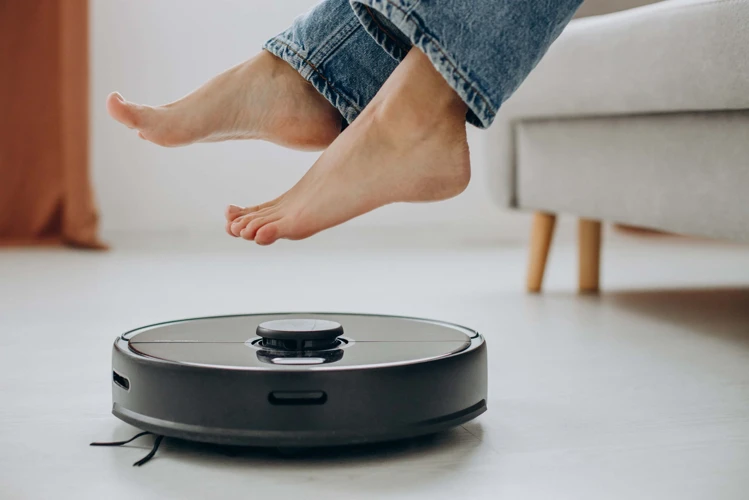
Smart sensors are becoming increasingly popular in household cleaning technology, especially in vacuum cleaners. Here are the benefits of smart sensors in a smart vacuum cleaner:
1. Increased Efficiency: With smart sensors installed in a vacuum cleaner, it can detect and avoid obstacles like furniture or stairs, creating a more efficient cleaning process. This not only saves time but also ensures a thorough cleaning of the entire house.
2. Reduced Energy Consumption: Smart sensors in vacuum cleaners can detect when the machine is not required to run, thereby conserving energy. For example, when the vacuum cleaner is stuck or obstructed, the smart sensor will shut down the machine temporarily, resulting in energy-saving.
3. Minimal Human Intervention: With smart sensors in a vacuum cleaner, users can set cleaning schedules, and the vacuum will clean the house automatically without any human intervention. This feature is useful for individuals with busy schedules or those who need to multitask.
4. Enhanced Navigation and Mapping: Smart sensors in a vacuum cleaner can map out floor plans and track the position and cleaning progress of the machine. This allows for efficient cleaning and avoids the vacuum’s repeated cleaning of the same spot.
5. Improved Cleaning Performance: Smart sensors aid in detecting different types of flooring, including hardwood, carpet, and tiles, and modify the suction power and speed based on the floor type, resulting in better cleaning performance.
Incorporating smart sensors in a vacuum cleaner can significantly improve cleaning efficiency, save energy, and require minimal human intervention, which saves time for users. It allows the machine to clean the house systematically, resulting in maximum cleaning capacity.
3.1 Increased Efficiency
Smart sensors are revolutionizing the cleaning industry by significantly enhancing the efficiency of cleaning equipment. Among the many benefits of using smart sensors in a smart vacuum cleaner, the most prominent one is the dramatic increase in cleaning efficiency. With smart sensors, the vacuum cleaner can detect and avoid obstacles, sense surface types, and map out the area for efficient cleaning. As a result, it ensures optimal cleaning performance while using minimal energy and little human intervention. In this section, we will delve deeper into how smart sensors enhance cleaning efficiency and what benefits they bring to smart vacuum cleaners.
3.2 Reduced Energy Consumption
One of the major benefits of smart sensors in a smart vacuum cleaner is reduced energy consumption, which is crucial for both environmental and economic reasons. The following are ways in which smart sensors lead to decreased energy consumption:
- Efficient Cleaning Path: Smart sensors enable a smart vacuum cleaner to map the floor plan of your home, identify obstacles and plan the most efficient cleaning path. This means that the vacuum cleaner does not have to move around aimlessly, repeatedly clean the same area or waste energy cleaning already clean spaces.
- Auto-adjusting Suction: Smart sensors in a smart vacuum cleaner can detect the type of surface it is cleaning and adjust its suction power accordingly. For instance, low-pile carpets require less suction power than high-pile carpets, and hard floors require even less suction power. By adjusting its suction power, the vacuum cleaner operates more efficiently and uses less energy.
- Smart Navigation: Smart sensors such as infrared sensors and ultrasonic sensors allow a smart vacuum cleaner to detect obstacles in its path and navigate around them. This reduces energy consumption because the vacuum cleaner does not have to apply excessive force or push through obstacles, which can result in increased energy consumption.
- Auto-docking and Recharging: Most smart vacuum cleaners come with a docking station that enables the vacuum cleaner to automatically dock and recharge when not in use or when low on battery charge. This feature ensures that the vacuum cleaner is always ready for use and does not waste energy by running on low battery charge or leaving charging cables plugged in unnecessarily.
- Scheduled Cleaning: With a smart vacuum cleaner, you can schedule cleaning at specific times when your home needs it the most. This means that the vacuum cleaner does not have to be running for extended periods when not needed, resulting in significant energy savings.
The sophisticated applications of smart sensors in a smart vacuum cleaner can lead to significant energy savings, making them an eco-friendly and financially smart choice for homeowners. By reducing energy consumption, they also help to reduce carbon emissions, contributing to the efforts of preserving the environment.
3.3 Minimal Human Intervention
Smart sensors play a crucial role in reducing human intervention required for cleaning with a vacuum cleaner. With the incorporation of these sensors, the cleaning process has become highly automated and requires minimal human involvement. Here are some of the ways in which smart sensors minimize the need for human intervention:
- Automated Cleaning Schedule: Smart sensors enable the vacuum cleaner to create its cleaning schedule without the need for user intervention. This means that the vacuum cleaner can automatically start cleaning at the preset time and clean the designated areas without any human assistance.
- Obstacle Detection: Smart sensors enable the vacuum cleaner to detect obstacles such as furniture or toys, and navigate around them to avoid collisions. This means that users do not have to move objects out of the way or supervise the cleaning process.
- Stair Detection: Smart sensors ensure that the vacuum cleaner does not fall down the stairs or encounter any other potential hazards. The vacuum cleaner can detect the edge of the stairs and navigate around it safely.
- Auto Charging: When the battery of the vacuum cleaner is running low, smart sensors enable the vacuum cleaner to automatically return to the charging dock and recharge. This means that users do not have to keep an eye on the vacuum cleaner or manually charge it.
With these smart sensors, users can be assured of a hassle-free cleaning experience that requires minimal human intervention. Smart vacuum cleaners with sensors are ideal for busy individuals who have limited time to clean or do not want to spend time supervising the cleaning process.
3.4 Enhanced Navigation and Mapping
One of the major benefits of smart sensors in a smart vacuum cleaner is an enhanced navigation and mapping capability. Smart vacuums are equipped with various sensors that allow them to map the layout of the room and navigate accordingly. They can detect obstacles and map out the entire cleaning route for maximum efficiency.
These smart sensors help in building an accurate map of the room and can determine the most efficient cleaning path. This helps in avoiding duplicate cleaning of certain areas and ensures that every corner is covered. They also help in adapting to changes in the layout of the room, such as moving furniture, and adjust their cleaning path accordingly.
To achieve enhanced navigation and mapping capabilities, smart vacuum cleaners use a combination of sensors, such as optical, infrared, and ultrasonic. All of these sensors work together to create an accurate map of the room and ensure the vacuum cleaner moves smoothly without bumping into obstacles.
These sensors also help in detecting a change in floor surfaces and adjust the vacuum’s suction power accordingly. For example, if the vacuum encounters a carpeted surface, it will automatically adjust its suction power to ensure that the carpet is thoroughly cleaned.
The following table summarizes the benefits of enhanced navigation and mapping capabilities:
| Benefits | Description |
|---|---|
| Efficient cleaning | Smart sensors help in building an accurate map of the room and determine an efficient cleaning path, avoiding duplicate cleaning of certain areas. |
| Adapts to room changes | Smart sensors help the vacuum cleaner adjust to any changes in room layout or furniture, adapting the cleaning path accordingly. |
| Detects floor surfaces | The sensors help to identify different floor surfaces and adjust the vacuum’s suction power accordingly. |
| Smooth navigation | Smart sensors allow the vacuum cleaner to navigate smoothly around obstacles without bumping into them. |
The enhanced navigation and mapping capabilities of smart sensors in a smart vacuum cleaner allow for efficient and thorough cleaning. With an accurate map of the room and the ability to detect changes in floor surfaces, the vacuum cleaner can easily adapt to any cleaning situation. And, by smoothly navigating around obstacles, the vacuum cleaner can provide a thorough cleaning experience without any unnecessary issues.
3.5 Improved Cleaning Performance
Smart sensors are designed to enhance the cleaning performance of smart vacuum cleaners. The sensors achieve this by providing more accurate and precise data about the layout of the cleaning environment. This section will describe how smart sensors contribute to improved cleaning performance, as shown in the following table:
| Improved Cleaning Performance Factors | Description |
|---|---|
| Targeted Cleaning | Smart sensors help the smart vacuum cleaner to locate the exact position of dirt, debris, or part of the room that needs cleaning. By accurately detecting the location of dirt, the vacuum cleaner can clean the targeted areas more efficiently. |
| Complete Coverage | The smart sensors provide the smart vacuum cleaner with a map of the cleaning environment. Consequently, it’s easy for the device to determine the areas that it has cleaned and those that it hasn’t. This ensures that the vacuum cleaner comprehensively covers the cleaning space without the need for human intervention. |
| Improved Suction Power | With the help of smart sensors, the vacuum cleaner can detect the floor type and adjust suction power accordingly. For instance, it will automatically switch to a higher suction power when cleaning carpets and switch to a lower power setting when cleaning hard floors. This feature ensures that the vacuum cleaner uses the appropriate amount of energy, which leads to improved cleaning performance. |
| Edge Cleaning | Most smart vacuum cleaners come with edge cleaning sensors that detect corners and edges. The sensors help the vacuum cleaner to navigate around furniture and walls while leaving no dirt behind. By detecting and cleaning the edges, the smart vacuum cleaner ensures that the entire cleaning space is covered. |
| Pet Hair Detection | Pet hair is often a problem when cleaning, but smart sensors can detect pet hair and adjust suction power accordingly. This ensures that the vacuum cleaner picks up pet hair and other allergens from carpets, floors, and furniture. |
As such, it is clear that smart sensors contribute to improved cleaning performance in various ways. If you are looking to buy a smart vacuum cleaner, make sure that it has the appropriate sensors to enhance cleaning efficiency.
How Smart Sensors Work in a Smart Vacuum Cleaner?
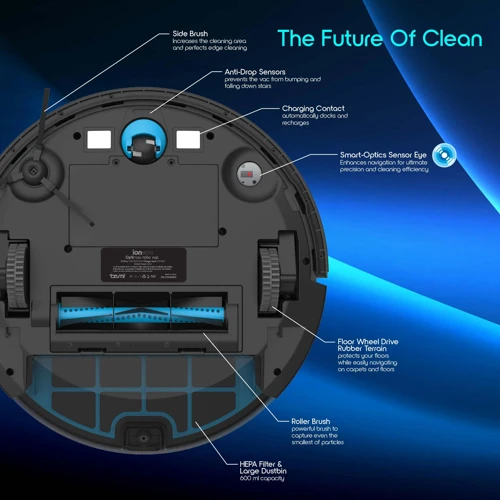
Smart sensors in a smart vacuum cleaner are an essential technology that enable the device to navigate around obstacles, adjust suction power, and detect surface types. Let’s explore how these sensors work in more detail.
Sensing Obstacles and Stairs: Smart sensors in a vacuum cleaner use a combination of infrared, ultrasonic, and optical sensors to detect obstacles in their path. These sensors scan the environment and map out the layout of the room. If the vacuum cleaner encounters an obstacle, it will pause or adjust its path to avoid it. Similarly, smart sensors enable the vacuum cleaner to detect stairs so that it doesn’t topple over.
Detecting Surface Type: Different surfaces require varying suction power to give them a thorough clean. Smart sensors can detect the kind of surface that the vacuum cleaner is on, and adjust the suction power accordingly. For example, carpets require higher suction power while hardwood floors require less.
Adjusting Suction Power: Smart sensors in a vacuum cleaner adjust suction power based on the surface type, but they can also adjust suction power based on the amount of dirt on the floor. The sensors detect the amount of dirt and debris on the floor and adjust suction power accordingly to ensure that every nook and cranny is cleaned efficiently.
Edge Cleaning: Smart sensors can detect edges and corners, and adjust the suction power to ensure thorough cleaning in tight spaces. They enable the vacuum cleaner to clean up to the very edge of a room, and around furniture legs, without leaving any dust or debris behind.
Pet Hair Detection: Pet hair can be notoriously difficult to clean, but smart sensors can detect it with ease. They use acoustic sensors to detect the sound of pet hair being picked up, enabling the vacuum cleaner to target the area and ensure thorough cleaning.
Smart sensors are a crucial element in the functioning of a smart vacuum cleaner. They enable the device to adjust suction power based on the type of surface and amount of dirt, detect obstacles and stairs, clean edges and corners efficiently, and even detect pet hair.
4.1 Sensing Obstacles and Stairs
As homes and offices come in various shapes and sizes, it’s vital that smart vacuum cleaners are capable of navigating around obstacles and knowing the difference between stairs and regular flooring. This is where the smart sensor technology comes into play. By using a combination of optical, infrared, and ultrasonic sensors, a smart vacuum can detect objects and change direction accordingly. But how exactly do these sensors work together to ensure that the vacuum cleaner doesn’t bump into furniture or fall down the stairs? Let’s dive deeper into sensing obstacles and stairs with smart sensors in a smart vacuum cleaner.
4.2 Detecting Surface Type
Smart sensors in a smart vacuum cleaner not only detect obstacles and stairs but also help in detecting the type of surface being cleaned. This feature helps in adjusting the suction power and brush roll speed to optimize cleaning performance. Here are some ways smart sensors detect different types of surfaces:
- Optical sensors: Optical sensors use light beams to detect the color and contrast of the surface. They work well for detecting hard floors and low pile carpets.
- Infrared sensors: Infrared sensors detect the distance between the vacuum and the surface being cleaned. They work well for detecting changes in surface height, such as going from hardwood to a rug.
- Ultrasonic sensors: Ultrasonic sensors emit high-frequency sound waves that bounce off surfaces to detect differences in texture and density. They work well for detecting soft surfaces such as shag carpets.
Using the data collected by these sensors, the smart vacuum cleaner can adjust its cleaning settings to optimize performance. For example, if the sensor detects a carpeted surface, it will automatically adjust the suction power and brush roll speed to provide a deeper clean. On the other hand, if it detects a hard floor surface, it will reduce the suction power to prevent scattering debris.
The ability of smart sensors to detect different types of surfaces greatly enhances the cleaning efficiency of a smart vacuum cleaner. By optimizing cleaning settings for each surface type, it ensures a thorough cleaning performance while avoiding damage to delicate surfaces.
4.3 Adjusting Suction Power
Smart sensors in a smart vacuum cleaner also allow for the adjustment of the suction power to optimize cleaning performance. The suction power needs to be adjusted based on the type of surface being cleaned, and smart sensors enable this adjustment to be made automatically.
The suction power adjustment is made possible by the sensor that detects the type of surface being cleaned. Table below highlights different types of surfaces and the suction power required to clean them efficiently.
| Surface Type | Suction Power Required |
|---|---|
| Carpet | High suction power required to remove embedded dirt and pet hair |
| Hardwood or Tile | Low suction power required to prevent the vacuum from damaging the surface |
| Stairs | Low suction power required to prevent the vacuum from falling off the stairs |
| Upholstery | Medium suction power required to remove dirt and pet hair without damaging the fabric |
Adjusting the suction power to fit the surface being cleaned not only offers a more thorough cleaning experience, but also helps conserve energy. A smart vacuum cleaner with smart sensors, such as an optical or infrared sensor, can easily detect the surface and adjust the suction power accordingly, thereby saving energy and extending the battery life of the device.
4.4 Edge Cleaning
Edge cleaning is a crucial task that often gets overlooked while cleaning, especially in households where the edges of the room tend to accumulate dirt and debris. However, with the help of smart sensors, it is possible to clean even the edges of the room effectively.
Smart vacuum cleaners come equipped with edge sensors that help them detect obstacles like walls, furniture, and other objects placed along the edges of the room. These sensors send signals to the vacuum cleaner, which then adjusts its cleaning patterns to clean along the edges effectively.
How do these sensors work?
The edge sensors are usually placed on the sides of the vacuum cleaner near the brushes. As the vacuum cleaner moves along the edges of the room, the sensors will detect the edges of the wall or furniture and send signals to the vacuum cleaner.
What happens next?
Based on the signal received from the edge sensors, the vacuum cleaner will adjust its cleaning pattern to focus on the edges of the room. This means that the vacuum cleaner will clean along the edges of the room in a way that no dirt or debris is left behind.
What are the benefits of edge cleaning with smart sensors?
The benefits of edge cleaning with smart sensors are numerous. First, it ensures that every corner of the room is cleaned thoroughly, leaving no dirt or debris behind. This helps to improve indoor air quality, which is essential for people with allergies or respiratory problems.
Edge cleaning with smart sensors also saves time and energy by eliminating the need for manual cleaning along the edges of the room. It also prevents damage to the vacuum cleaner’s brushes when cleaning along the edges of furniture.
With the help of smart sensors, edge cleaning can be a highly effective cleaning task, which results in better cleaning performance and improved indoor air quality.
4.5 Pet Hair Detection
Smart sensors in a vacuum cleaner can detect pet hair and adjust the suction power accordingly. Pet hair detection is particularly important for pet owners because pet hair can be notoriously difficult to clean.
Here are some factors to keep in mind when it comes to pet hair detection in a smart vacuum cleaner:
| Factor | Description |
|---|---|
| Sensors | Smart sensors in a vacuum cleaner can detect pet hair and other debris, and adjust suction power accordingly for optimal cleaning. |
| Cleaning Brushes | Many smart vacuums come equipped with brushes specifically designed for removing pet hair from carpets and upholstery. |
| Mapping | Some smart vacuums use mapping technology to track where pets spend most of their time, allowing for more efficient cleaning of pet hair and dander. |
| Filtration System | An advanced filtration system is important for pet owners as it can capture pet hair, dander, and other allergens that may be present in the air. |
Smart sensors in a vacuum cleaner that detect and adjust for pet hair can be a game-changer for pet owners who want to maintain a clean home without spending countless hours cleaning themselves. It is worth considering this feature when looking for a smart vacuum cleaner, particularly if you have pets that shed frequently.
Factors to Consider When Buying a Smart Vacuum Cleaner
When it comes to buying a smart vacuum cleaner, there are certain factors that you need to consider before making a decision. Let’s take a look at five important factors that you should keep in mind:
Type of Smart Sensors: One of the most important factors to consider when buying a smart vacuum cleaner is the type of smart sensors it comes with. You need to ensure that the vacuum cleaner has the right sensors to detect obstacles, stairs, and surface type. Look for a vacuum cleaner that has a combination of sensors to ensure that it can efficiently clean your home.
Level of Automation: The level of automation in a smart vacuum cleaner can vary greatly depending on the brand and model. Some vacuum cleaners have a high level of automation, which means they can operate autonomously without any human intervention. Others require some degree of manual operation, such as emptying the dustbin or scheduling cleaning times. Consider your preferences when choosing a vacuum cleaner with the right level of automation.
Battery Life: Another important factor to consider when buying a smart vacuum cleaner is the battery life. You want to make sure that the vacuum cleaner can operate for a sufficient amount of time without needing to be recharged. Look for a vacuum cleaner with a long battery life if you have a larger home or if you want to use it frequently.
Price: Smart vacuum cleaners can vary greatly in price, with some models costing several hundred dollars while others are much more affordable. Consider your budget and what features are most important to you when choosing a vacuum cleaner. You don’t want to overspend on features that you don’t need, but you also don’t want to sacrifice quality for a lower price.
Brand Reputation: Finally, it’s important to consider the reputation of the brand when buying a smart vacuum cleaner. Look for a brand that has a good reputation for producing high-quality products and providing good customer service. Reading reviews from other customers can also give you an idea of the quality of the vacuum cleaner and the brand’s reputation.
By considering these factors, you can choose the right smart vacuum cleaner that meets your needs and makes cleaning your home more efficient.
5.1 Type of Smart Sensors
When it comes to buying a smart vacuum cleaner, one of the most important factors to consider is the type of smart sensors it uses. Smart sensors are what enable these vacuums to navigate your home, clean efficiently, and avoid obstacles. With so many different types of smart sensors available, it can be difficult to know which ones will best meet your needs. In this section of our guide, we’ll explore some of the different types of smart sensors you’ll encounter when shopping for a smart vacuum cleaner. By the end, you’ll have a better understanding of which types of smart sensors are most important for your cleaning needs.
5.2 Level of Automation
When considering buying a smart vacuum cleaner, one of the most important factors to consider is the level of automation. The level of automation denotes how much human intervention is needed to operate the device. There are three levels of automation available in smart vacuum cleaners: low, medium, and high.
| Level of Automation | Description |
|---|---|
| Low | A device with low automation requires the most amount of human interaction. It has to be manually switched on and off, and users need to physically move it from room to room. While low automation devices might be more affordable, they offer less convenience and lack the advanced features of the other two categories. |
| Medium | A device with medium automation is partially autonomous, meaning it requires some human input but not as much as a low automation device. It can be scheduled to clean a specific room, and users can customize settings such as suction power, cleaning modes, and navigation patterns. Medium automation devices are more advanced and offer more features than low automation devices. |
| High | Highly automated devices are the most advanced and require minimal human input. They can be controlled, scheduled, and monitored remotely via a mobile app or virtual assistant. They have advanced sensors that detect obstacles, stairs, and surface types, and can adjust their cleaning pattern accordingly. High automation devices are typically more expensive than the other two categories but offer unmatched convenience and advanced features. |
Ultimately, the level of automation you choose depends on your budget, lifestyle, and cleaning needs. If you have a smaller home or apartment and do not mind manually moving the device from room to room, a low automation device may suffice. If you have a larger home or want more advanced features, a medium or high automation device might be a better choice. It is important to carefully consider your options and choose a smart vacuum cleaner that will provide you with the most value and convenience.
5.3 Battery Life
The battery life of a smart vacuum cleaner is a crucial factor to consider when making a purchase. Nobody wants a cleaning device that cannot finish a job without running out of battery power. Thus, it is essential to pay attention to the battery life of the smart vacuum cleaner before buying it.
The battery life can depend on different factors such as:
| Factor | Effect on Battery Life |
|---|---|
| Battery Size | The bigger the battery, the more power it can store, leading to longer battery life. |
| Surface area to be cleaned | The larger the surface area, the more battery power is consumed to cover it in a single charge. |
| Suction Power | The higher the suction power, the more energy the vacuum cleaner needs, leading to shorter battery life. |
| Smart Features | The more advanced features of the vacuum cleaner, such as smart sensors, can consume more battery power, leading to shorter battery life. |
It is important to pay attention to the type of battery used in the smart vacuum cleaner. Some batteries, such as Lithium-ion, are known to last longer and recharge faster than others.
Another important aspect to consider is the charging time:
Some smart vacuum cleaners may take several hours to charge, while others may need only an hour or so. It’s important to keep in mind that the charging time affects the overall cleaning efficiency of the vacuum cleaner. If you need a smart vacuum cleaner that can clean a large surface area continuously, you’ll need one with a longer battery life and a shorter charging cycle.
Battery life and charging time are important factors to consider when buying a smart vacuum cleaner. It is important to choose a model that can meet your cleaning needs without running out of battery power in the middle of cleaning.
5.4 Price
When it comes to buying a smart vacuum cleaner, pricing is always a crucial factor to consider. The cost of a smart vacuum cleaner can vary based on various factors such as brand, features, type of sensors, and level of automation. Here are some pointers to help you make a choice based on price:
- Entry-level smart vacuum cleaners: These models are typically the cheapest and can cost between $100 to $300. They come with basic features and sensors such as optical sensors but may not be as efficient as higher-end models. If you are on a budget, an entry-level smart vacuum cleaner can be a good option for you.
- Mid-range smart vacuum cleaners: These models come with more advanced sensors such as infrared and ultrasonic sensors and are priced between $300 to $600. They typically have better cleaning efficiency, improved navigation, and mapping capabilities. If you are looking for more advanced features without breaking the bank, a mid-range smart vacuum cleaner can be the right choice for you.
- High-end smart vacuum cleaners: These models are the most expensive, priced between $600 to $1000. They come with the latest and most advanced sensors and features such as pet hair detection, edge cleaning, and adjustable suction power. They also often have a longer battery life and are more durable. If you want the best of the best and don’t mind spending some extra bucks, a high-end smart vacuum cleaner will never disappoint you.
It is essential to consider the pricing of a smart vacuum cleaner in relation to the features it offers. While a high-end model may be expensive, it will offer unparalleled cleaning efficiency, improved navigation, and mapping capabilities which can save you time in the long run. On the other hand, an entry-level model may cost less but may not have powerful sensors, resulting in reduced efficiency and potentially requiring frequent manual intervention. Eventually, the price you pay for a smart vacuum cleaner should align with the features you want for a clean, tidy, and comfortable home.
5.5 Brand Reputation
When it comes to investing in a smart vacuum cleaner, brand reputation is an important factor to consider. A good brand is not only a mark of quality but also a guarantee of reliability and customer support. Here are a few points that one should keep in mind while choosing a smart vacuum cleaner based on brand reputation:
- Reviews and ratings: Before making a purchase, it is always recommended to check out the reviews and ratings of the product online. This will give a fair idea about the performance and durability of the product.
- Warranty: A good brand offers a warranty on its products. A warranty period of 1-2 years is generally considered standard, but some brands offer even longer warranties.
- Customer support: A brand that values its customers offers good customer support. This includes providing prompt assistance in case of any issues, offering repair and replacement services, and responding to customer queries in a timely manner.
- Experience: A brand that has been in the market for a long time is likely to have more experience in manufacturing and designing smart vacuum cleaners. This means that the product will be more refined and efficient.
- Product range: A brand that offers a range of smart vacuum cleaners is more likely to have a deeper understanding of the market and customer needs. It also provides customers with a choice to select a product that suits their requirements and budget.
Considering these factors, one can shortlist a few brands that they find reliable and trustworthy. However, it is important to note that a good brand may come at a higher price point. While it may be tempting to go for a cheaper alternative, investing in a good brand can save money in the long run by reducing the need for repairs or replacements.
Conclusion
In conclusion, it is safe to say that smart sensors have revolutionized the art of cleaning. The integration of smart sensors in the cleaning industry has brought about numerous benefits, including increased efficiency, reduced energy consumption, minimal human intervention, enhanced navigation and mapping, and improved cleaning performance.
By using optical sensors, infrared sensors, ultrasonic sensors, tactile sensors, and acoustic sensors, smart vacuum cleaners can detect obstacles and stairs, adjust suction power, detect surface type, undertake edge cleaning, and even detect pet hair. This level of automation not only makes cleaning easier but also frees up time for other activities.
When considering buying a smart vacuum cleaner, it is essential to factor in the type of smart sensors, level of automation, battery life, price, and brand reputation. These factors will help you choose the right smart vacuum cleaner that best meets your cleaning needs.
Overall, the use of smart sensors in the cleaning industry has significantly transformed the way we clean our homes and workspaces. With increased efficiency and minimal human intervention, smart sensors make cleaning tasks easier and less time-consuming, ultimately providing a more comfortable and clean living and working environment.
Frequently Asked Questions
1. What are smart vacuum cleaners?
Smart vacuum cleaners are technologically advanced cleaning devices equipped with smart sensors that enhance their cleaning efficiency. They are designed to clean effectively and navigate around obstacles and furniture easily.
2. What are some of the benefits of using smart vacuum cleaners?
Some of the benefits of using smart vacuum cleaners include increased efficiency, reduced energy consumption, minimal human intervention, enhanced navigation and mapping, and improved cleaning performance.
3. What types of smart sensors are used in smart vacuum cleaners?
The most common types of smart sensors used in smart vacuum cleaners are optical sensors, infrared sensors, ultrasonic sensors, tactile sensors, and acoustic sensors.
4. How do smart sensors work in a smart vacuum cleaner?
Smart sensors work by detecting and analyzing data from the environment to navigate around obstacles and furniture, detect surface types, adjust suction power, clean edges, and detect pet hair.
5. Should I consider buying a smart vacuum cleaner?
If you are looking for a cleaning device that can clean efficiently with minimal human intervention, a smart vacuum cleaner is an excellent option to consider. They are perfect for busy households and those who do not have enough time for cleaning.
6. What are some factors to consider when buying a smart vacuum cleaner?
Some important factors to consider when buying a smart vacuum cleaner include the type of smart sensors used, the level of automation, battery life, price, and brand reputation.
7. Can smart vacuum cleaners navigate stairs?
Most smart vacuum cleaners are equipped with smart sensors that enable them to detect stairs and avoid falling off. This feature ensures they stay safe and avoid damage during cleaning.
8. How long do the batteries of smart vacuum cleaners last?
The battery life of smart vacuum cleaners varies from one model to another. However, most models have batteries that can last for up to two hours, depending on the cleaning mode and the size of the area to be cleaned.
9. Can smart vacuum cleaners be controlled remotely?
Yes, most smart vacuum cleaners can be controlled remotely through Wi-Fi connectivity and a mobile app. This feature enables you to start and stop the device, adjust cleaning modes, and check the cleaning progress from anywhere.
10. How do smart vacuum cleaners map their environment?
Smart vacuum cleaners map their environment by using smart sensors to detect and analyze data from the surroundings. They create a virtual map of the area to be cleaned, which enables them to navigate around obstacles and furniture easily and clean efficiently.
